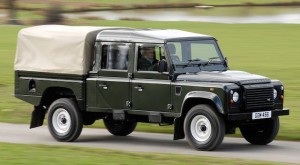
Patent drawings filed in the United States of a stretched-body version of the current Land Rover Defender 110 have been doing the rounds of the internet.
The longer vehicle has been tagged by media as the new Land Rover Defender 130, after the original 130 which first appeared in the 1980s as a crew-cab and became a target for special purpose conversions.
But the 130 is by no means the longest Land Rover. That honour belongs to an exclusive version of the previous model Defender. I took the above picture of it in August 2011, at Land Rover headquarters in the English midlands.
 Whereas the standard 130 model (pictured at right) had four doors, two rows of seats, and two windows on each side ahead of a flat deck, the s-t-r-e-t-c-h-i-e-s-t version had six doors, three rows of seats, and four windows on each side – with room at the rear for cargo.
Whereas the standard 130 model (pictured at right) had four doors, two rows of seats, and two windows on each side ahead of a flat deck, the s-t-r-e-t-c-h-i-e-s-t version had six doors, three rows of seats, and four windows on each side – with room at the rear for cargo.
It was specially built as a support vehicle for the Land Rover Experience programme – off-road driving tuition – and was licenced in the UK only for use on private property.
Land Rover did what it had done to make the first 130: it cut and extended the 110’s chassis, adding around 44cm to the overall length. Only for the six-door it made the 130 chassis much longer again.
The so-called new Defender 130 has been spied heavily camouflaged and testing in Germany. Speculative reports vary on its production date: some say later this year; others not until 2023-24.
 The wheelbase of the 130 – the distance between the front and rear wheels – is understood to be the same as the current Land Rover Defender 110, but the body length is stretched behind the rear wheels to create a visibly larger cargo hold. Overall, the 130 is believed to be just over 5m in length. The Defender 110 is 4.6m.
The wheelbase of the 130 – the distance between the front and rear wheels – is understood to be the same as the current Land Rover Defender 110, but the body length is stretched behind the rear wheels to create a visibly larger cargo hold. Overall, the 130 is believed to be just over 5m in length. The Defender 110 is 4.6m.
It’s likely the 130 – if it does go into production – will use the same engine line-up as the two-door 90 and four-door 110: Ingenium six-cylinder petrol and diesel options, along with a supercharged V8.
The original Defender 130 was available with four-cylinder engines from the 90 and 110, but it soon became apparent that they were not up to the task of hauling the vehicle’s extra weight. Engine choices thereafter were the 3.5-litre petrol V8 or 2.5-litre turbocharged diesel.
